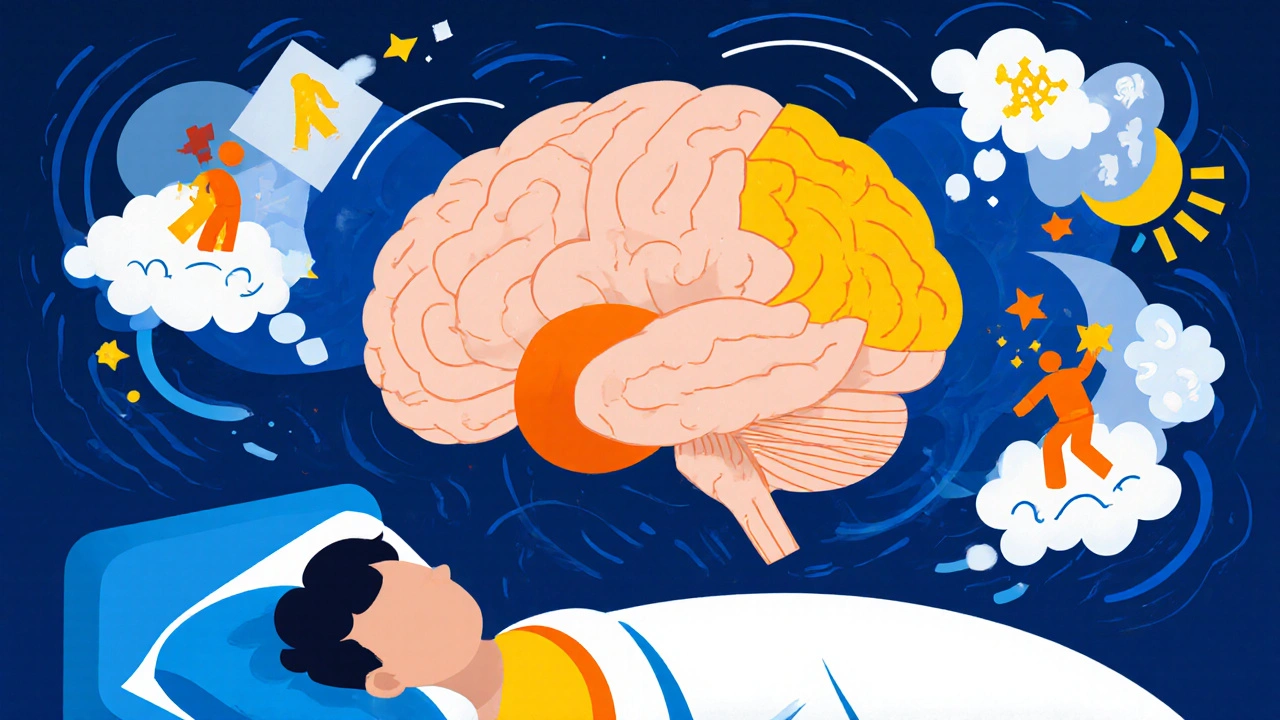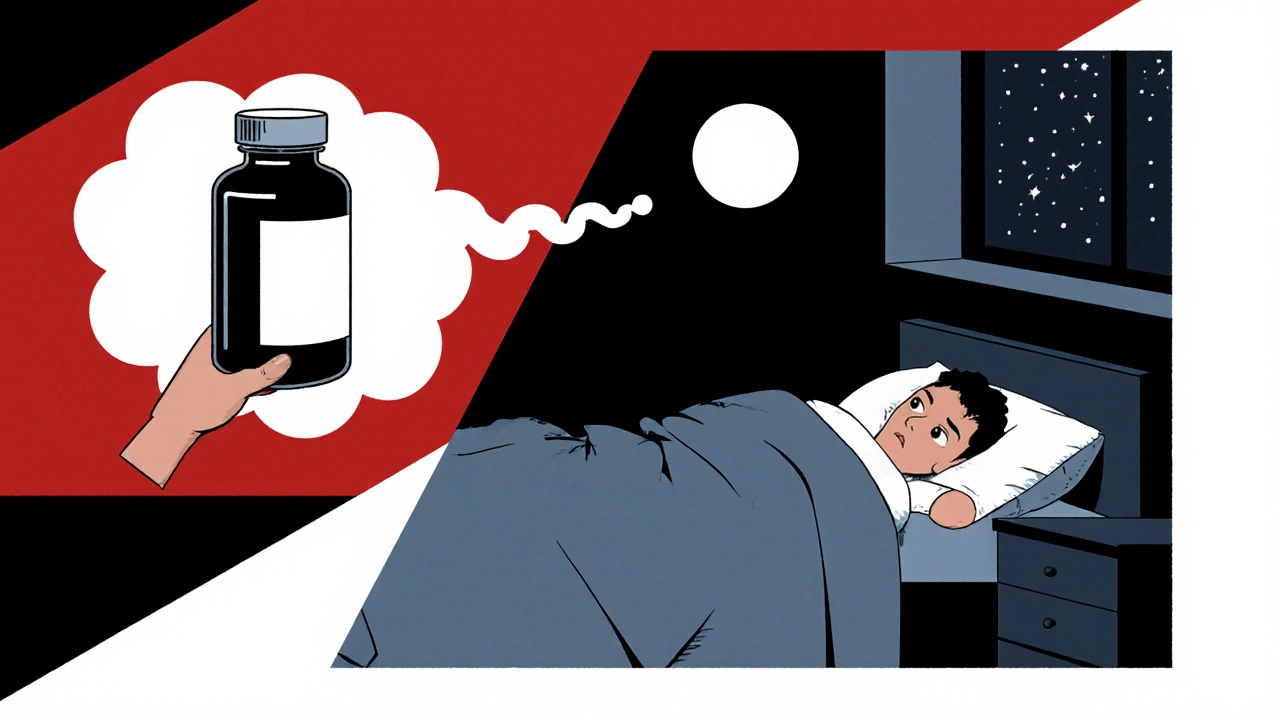Varenicline Sleep Impact Estimator
This tool helps you estimate your risk of sleep disturbances while taking varenicline based on factors discussed in the article. It's not a substitute for professional medical advice.
Your Risk Factors
When doctors prescribe Varenicline is a partial agonist of the α4β2 nicotinic acetylcholine receptor used to help people quit smoking. It received approval from the FDA in 2006 and from the UK MHRA in 2008. While many patients notice reduced cravings and fewer relapses, a growing body of research shows the drug can also mess with your night‑time routine. If you’ve ever wondered whether that new prescription is stealing your shut‑eye, you’re in the right place.
Quick Takeaways
- Varenicline can cause insomnia, vivid dreams, and occasional nightmares in up to 30% of users.
- Risk peaks during the first two weeks of treatment and often eases after the dose is tapered.
- Good sleep hygiene, timing the dose earlier, and short‑term use of melatonin can help.
- Other cessation aids-Bupropion and Nicotine Replacement Therapy (NRT)-have milder sleep‑related side effects.
- If sleep problems persist, consult your clinician; they may adjust the regimen or switch therapies.
How Varenicline Works (and Why It Can Touch Your Dreams)
The drug’s primary job is to trick the brain’s nicotine receptors into thinking nicotine is still present, which eases withdrawal. However, those same receptors sit in brain regions that regulate sleep cycles, especially the thalamus and brainstem. By partially activating them, varenicline can alter the balance between rapid‑eye‑movement (REM) sleep and non‑REM stages. The result? More time in REM, which explains the reports of unusually vivid dreams or night‑time awakenings.
Common Sleep‑Related Side Effects
Clinical trials and post‑marketing surveillance have identified a handful of sleep‑related complaints:
- Insomnia: difficulty falling asleep or staying asleep, reported by roughly 20‑30% of users.
- Vivid Dreams: dreams that feel unusually real, often remembered in detail.
- Nightmares: distressing or frightening dream content, occasionally leading to early awakenings.
- Sleep Fragmentation: frequent brief arousals that reduce overall sleep quality.
Most of these effects appear within the first 7‑14 days and tend to lessen as the body adapts to the medication.
Who Is Most Likely to Experience Sleep Problems?
Not everyone gets rattled by varenicline. Certain factors raise the odds:
- Pre‑existing insomnia or anxiety disorders.
- High initial dose (often 0.5 mg twice daily for three days before moving to 1 mg).
- Concurrent use of stimulants like caffeine or certain antidepressants.
- Genetic variations affecting nicotinic receptor sensitivity (studies from the University of Michigan show a 1.5‑fold increase in REM disturbances among carriers of the CHRNA5 allele).
If you fall into any of these groups, keep a simple sleep diary for the first two weeks. Note bedtime, wake‑time, and any dream recollection. The data will help your clinician decide whether a dosage tweak is needed.

Practical Tips to Tame the Nighttime Effects
Below is a checklist you can start using today. Most items are low‑effort, but together they can make a noticeable difference.
- Take the medication earlier: Aim for a morning dose rather than a split‑day schedule. If a twice‑daily regimen is required, set the second pill no later than early afternoon.
- Limit caffeine after 2 p.m. Caffeine can amplify the stimulating effect on nicotinic receptors.
- Establish a wind‑down routine: Dim lights, avoid screens, and try a brief meditation or breathing exercise 30 minutes before bed.
- Consider melatonin (0.5‑1 mg) for the first two weeks if insomnia persists. Discuss dosage with your prescriber.
- Stay active during the day: Light exercise (a 20‑minute walk) can stabilize circadian rhythms.
- Monitor alcohol: Alcohol may worsen REM disturbances.
- Report severe nightmares: If they cause daytime anxiety or lead to safety concerns, seek medical advice promptly.
Comparing Sleep Impact of Popular Cessation Aids
| Medication | Insomnia (% of users) | Vivid Dreams / Nightmares | Typical Dose Schedule | Regulatory Body |
|---|---|---|---|---|
| Varenicline | 20‑30% | 15‑25% experience vivid dreams; 5‑10% report nightmares | 0.5 mg BID → 1 mg BID → 1 mg BID (24 weeks) | FDA, MHRA |
| Bupropion | 5‑10% | ~5% vivid dreams; nightmares rare | 150 mg daily → 150 mg BID (7‑12 weeks) | FDA, EMA |
| Nicotine Replacement Therapy (NRT) | 2‑5% | Rare; occasional vivid dreams when using high‑dose patches | Patch 21 mg/24 h → taper; gum 2‑4 mg PRN | FDA, MHRA |
As the numbers show, varenicline carries a higher sleep‑disturbance risk compared with Bupropion and NRT. However, its overall quit‑rate (about 44% at one year) still outperforms the alternatives for many smokers, according to a 2023 Cochrane review.
Regulatory Perspective and Safety Monitoring
Both the FDA and the UK MHRA require manufacturers to include sleep‑related side effects in the prescribing information. Post‑marketing surveillance in the United Kingdom (2022‑2024) flagged 1,237 reports of insomnia linked to varenicline, prompting updated patient‑leaflet warnings.
Healthcare providers are encouraged to use the Yellow Card Scheme (UK) or FDA MedWatch (US) to report any severe sleep reactions. This data helps regulators refine dosage recommendations and develop risk‑mitigation strategies.
When to Seek Professional Help
Most sleep disturbances settle within 4‑6 weeks, but keep an eye out for these red flags:
- Persistent insomnia lasting more than two weeks despite hygiene measures.
- Nightmares that cause daytime anxiety, flashbacks, or affect work performance.
- Any suicidal thoughts-varenicline carries a boxed warning for mood changes.
If you notice any of these, call your GP or the smoking‑cessation clinic. They may lower the dose, switch to Bupropion, or add a short‑term hypnotic under close supervision.
Bottom Line Checklist
- Track sleep patterns for the first month of treatment.
- Take varenicline in the morning; avoid evening dosing.
- Limit caffeine and alcohol after midday.
- Implement a consistent bedtime routine (no screens 30 min before sleep).
- If insomnia persists, discuss melatonin or a temporary dose reduction with your prescriber.
- Report severe nightmares or mood changes immediately.
Following these steps can help you stay on track with quitting while preserving the quality of your rest.
Frequently Asked Questions
Will varenicline make me stay awake all night?
Most users experience only mild sleep disruption, usually during the first two weeks. Severe insomnia is uncommon, but if it happens, talk to your doctor about adjusting the dose or timing.
Are vivid dreams a sign that the medication is working?
Not exactly. Vivid dreams are a side effect of the drug’s action on REM sleep, not a marker of nicotine‑craving reduction. They simply indicate the brain’s receptors are being stimulated.
Can I combine varenicline with nicotine patches to reduce sleep problems?
Combining therapies is not recommended without specialist guidance. Overlapping nicotine activity can heighten sleep disturbances and increase the risk of side effects.
Is melatonin safe to use with varenicline?
Melatonin is generally safe and can help reset the sleep‑wake cycle. A low dose (0.5‑1 mg) taken 30 minutes before bedtime is a common recommendation, but always check with your prescriber.
Should I stop varenicline if I develop nightmares?
Don’t stop abruptly. Talk to your clinician first. They may lower the dose, shift dosing times, or switch you to an alternative like Bupropion.
Sleep is a vital part of any quit‑smoking plan. By understanding how varenicline interacts with your brain’s sleep centers and by applying a few practical habits, you can keep both cravings and sleepless nights under control.






Recent data suggest that adjusting the dosing schedule of varenicline can significantly reduce the incidence of insomnia during the initial treatment phase. Patients are advised to take the first dose in the morning and avoid evening administration.
October 19DHARMENDER BHATHAVAR